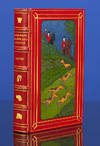

Color Slides of Gagaku. Dances and Music of the Japanese Imperial Court.
by (JAPAN: GAGAKU) GARFIAS, Robert
- Used
- Hardcover
- first
- Condition
- See description
- Seller
-
Portland, Oregon, United States
Payment Methods Accepted
About This Item
Tokyo: Kokusai Bunka Shinkokai (Society for International Cultural Relations), 1960. First edition. Octavo. 20 page introductory booklet by Garfias bound at front hinge, 6 fanfold cardstock pages housing 36 color slides of dancers, costumes, masks, musical instruments, stage, etc. bound at rear hinge. Publisher's Japon vellum, red lettering to spine and front, mulberry endpapers. Old stain to lower front corner (about a quarter of an inch) and general rubbing but still a very handsome copy with all the slides still present. Only one copy located by OCLC.
Gagaku is a type of Japanese classical music that was created by the fusion of music brought to Japan from continental Asia and Japanese original music and dance. It was developed as court music of the Kyoto Imperial Palace, and was established in the Heian period around the 10th century. It remains much like its 10th century iteration. In many ways it is simply the music of the Imperial Court. The popularity of gagaku reached its peak in the 9th century to the 10th century when court aristocracy began to hold private concerts, but declined in the Kamakura period (1185-1333) when the power of the court aristocracy became diminished while that of the samurai rose. Gagaku was played by musicians who belonged to hereditary guilds. During the Kamakura period, military rule was imposed and gagaku was performed rarely at court. At this time, there were three guilds, based in Osaka, Nara and Kyoto.
Because of the Onin War, a civil war from 1467 to 1477 during the Muromachi period, gagaku ensembles ceased to perform in Kyoto for about 100 years. In the Edo period, the Tokugawa Shogunate revived and reorganized the court-style ensembles, the direct ancestors of the present gagaku ensembles. After the Meiji Restoration of 1868, musicians from all three guilds came to the capital and their descendants make up most of the current Tokyo Imperial Palace Music Department.
Ethnomusicologist Robert Garfias worked in Japan, Korea, The Philippines, Mexico, Burma, Romania, Portugal, Puerto Rico and Turkey. He was a past President of the Society for Ethnomusicology and was appointed by the White House to the Council of the National Endowment for the Arts.
Reviews
(Log in or Create an Account first!)
Details
- Bookseller
- Nat DesMarais Rare Books, ABAA
(US)
- Bookseller's Inventory #
- 74819
- Title
- Color Slides of Gagaku. Dances and Music of the Japanese Imperial Court.
- Author
- (JAPAN: GAGAKU) GARFIAS, Robert
- Book Condition
- Used
- Quantity Available
- 1
- Binding
- Hardcover
- Publisher
- Kokusai Bunka Shinkokai (Society for International Cultural Relations)
- Place of Publication
- Tokyo
- Date Published
- 1960
Terms of Sale
Nat DesMarais Rare Books, ABAA
30 day return guarantee, with full refund including original shipping costs for up to 30 days after delivery if an item arrives misdescribed or damaged.
About the Seller
Nat DesMarais Rare Books, ABAA
Biblio member since 2012
Portland, Oregon
About Nat DesMarais Rare Books, ABAA
Nat DesMarais Rare Books specializes in books on the Sierra Nevada (particularly Yosemite), the Mojave, and California books in general. We also deal in the art of the American West, voyages and travels and nineteenth century literature.
Glossary
Some terminology that may be used in this description includes:
- Hinge
- The portion of the book closest to the spine that allows the book to be opened and closed.
- Vellum
- Vellum is a sheet of specialty prepared skin of lamb, calf, or goat kid used for binding a book or for printing and writing. ...
- Rubbing
- Abrasion or wear to the surface. Usually used in reference to a book's boards or dust-jacket.
- Spine
- The outer portion of a book which covers the actual binding. The spine usually faces outward when a book is placed on a shelf....
- First Edition
- In book collecting, the first edition is the earliest published form of a book. A book may have more than one first edition in...
- Octavo
- Another of the terms referring to page or book size, octavo refers to a standard printer's sheet folded four times, producing...

